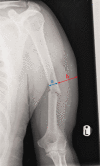Humeral shaft fractures: how effective really is functional bracing?
- PMID: 34804211
- PMCID: PMC8600666
- DOI: 10.1177/1758573220937402
Humeral shaft fractures: how effective really is functional bracing?
Abstract
Background: The aim of this study was to assess the effectiveness of functional bracing in the treatment of humeral shaft fractures and identify factors that increased the risk of delayed or non-union.
Methods: All patients with humeral shaft fractures treated at Musgrove Park Hospital between 2010 and 2017 were identified. Patient electronic records were reviewed to identify demographic data, as well as outcomes and complications following treatment. Radiographs were reviewed to identify fracture pattern and location as well as fracture displacement and angulation.
Results: In total, 65 patients were treated with functional bracing of which 22 patients (34%) had a delayed or non-union. Fracture displacement and angulation were significantly associated with delayed or non-union. In particular, patients with fractures displaced more than 30 mm or angulated more than 30° had a significantly higher risk of delayed or non-union. Fracture location or pattern was not significantly associated with delayed or non-union.
Conclusion: Functional bracing is an effective treatment modality for the majority of patients with humeral shaft fractures, but patients with markedly displaced or angulated fractures are at a higher risk of failure of conservative treatment and therefore early operative intervention should be considered.
Keywords: Sarmiento; delayed; fracture; functional bracing; humerus; non-union; shaft; union.
© 2020 The British Elbow & Shoulder Society.
Conflict of interest statement
Declaration of Conflicting Interests: The author(s) declared no potential conflicts of interest with respect to the research, authorship, and/or publication of this article.
Figures




Similar articles
-
Acute and chronic humeral shaft fractures in adults.Orthop Traumatol Surg Res. 2015 Feb;101(1 Suppl):S41-9. doi: 10.1016/j.otsr.2014.07.034. Epub 2015 Jan 17. Orthop Traumatol Surg Res. 2015. PMID: 25604002 Review.
-
Humeral shaft fractures: union outcomes in a large cohort.J Shoulder Elbow Surg. 2017 Nov;26(11):1881-1888. doi: 10.1016/j.jse.2017.07.001. J Shoulder Elbow Surg. 2017. PMID: 29054684
-
Nonoperative treatment of humeral shaft fractures revisited.J Shoulder Elbow Surg. 2015 Feb;24(2):210-4. doi: 10.1016/j.jse.2014.05.009. Epub 2014 Aug 1. J Shoulder Elbow Surg. 2015. PMID: 25088479
-
A Pre-fabricated Bracing System for the Management of Humeral Shaft Fractures: Experience of a Centre in the United Kingdom.Ortop Traumatol Rehabil. 2015 Oct;17(5):463-70. doi: 10.5604/15093492.1186816. Ortop Traumatol Rehabil. 2015. PMID: 26751746
-
Evaluation of Humeral Shaft Fracture Outcomes by Treatment Method: A Systematic Review and Meta-analysis Based on Comparison Studies.JBJS Rev. 2023 Jul 17;11(7). doi: 10.2106/JBJS.RVW.23.00037. eCollection 2023 Jul 1. JBJS Rev. 2023. PMID: 37459427
Cited by
-
Mechanical study of the safe distance between humerus shaft fracture and distal locking screws in antegrade nailing.BMC Musculoskelet Disord. 2025 May 10;26(1):461. doi: 10.1186/s12891-025-08711-y. BMC Musculoskelet Disord. 2025. PMID: 40349052 Free PMC article.
-
Medial minimally invasive plate osteosynthesis for humeral shaft fractures: a case series.Ann Med Surg (Lond). 2023 May 17;85(6):3171-3178. doi: 10.1097/MS9.0000000000000852. eCollection 2023 Jun. Ann Med Surg (Lond). 2023. PMID: 37363563 Free PMC article.
-
Clinical effect of operative vs nonoperative treatment on humeral shaft fractures: Systematic review and meta-analysis of clinical trials.World J Orthop. 2024 Aug 18;15(8):783-795. doi: 10.5312/wjo.v15.i8.783. eCollection 2024 Aug 18. World J Orthop. 2024. PMID: 39165869 Free PMC article.
-
Outcomes of intramedullary nailing versus plate fixation for humeral shaft fractures: a retrospective cohort study.Eur J Orthop Surg Traumatol. 2025 Feb 7;35(1):63. doi: 10.1007/s00590-025-04181-z. Eur J Orthop Surg Traumatol. 2025. PMID: 39915345 Free PMC article.
References
-
- Sarmiento A, Kinman PB, Galvin EG, et al. Functional bracing of fractures of the shaft of the humerus. J Bone Joint Surg Am 1977; 59: 596–601. - PubMed
-
- Walker M, Palumbo B, Badman B, et al. Humeral shaft fractures: a review. J Shoulder Elbow Surg 2011; 20: 833–844. - PubMed
-
- Ekholm R, Tidermark J, Törnkvist H, et al. Outcome after closed functional treatment of humeral shaft fractures. J Orthop Trauma 2006; 20: 591–596. - PubMed
-
- Shields E, Sundem L, Childs S, et al. The impact of residual angulation on patient reported functional outcome scores after non-operative treatment for humeral shaft fractures. Injury 2016; 47: 914–918. - PubMed
-
- Sarmiento A, Zagorski J, Zych G, et al. Functional bracing for the treatment of fractures of the humeral diaphysis. J Bone Joint Surg Am 2000; 82: 478–486. - PubMed
LinkOut - more resources
Full Text Sources
